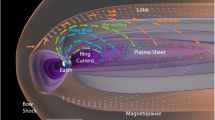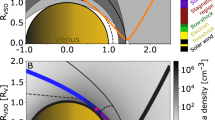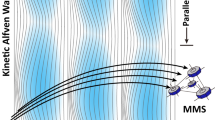Abstract
The presence of ‘contaminant’ heavy ions of planetary origin in the solar wind has long been the subject of intense theoretical and experimental research. Studies of their abundance, acceleration, and direction of motion are important because of their implications on the composition and dynamics of planetary and cometary plasma wakes. The plasma and magnetic field observations made with the Pioneer Venus Orbiter (PVO) at Venus have provided the opportunity to examine the conditions in which planetary ions are picked up by the solar wind. We show here that in the outer regions of the venusian far wake the displacement of planetary O+ particles, characteristic of the Venus upper ionosphere, does not occur necessarily along the magnetic field lines but approximately in the direction of the shocked solar wind.
This is a preview of subscription content, access via your institution
Access options
Subscribe to this journal
Receive 51 print issues and online access
$199.00 per year
only $3.90 per issue
Buy this article
- Purchase on Springer Link
- Instant access to full article PDF
Prices may be subject to local taxes which are calculated during checkout
Similar content being viewed by others
References
Michel, F. C. Planet. Space Sci. 1530, 19 (1971).
Wallis, M. K. & Ong, R. S. B. Planet. Space Sci. 23, 713 (1975).
Cloutier, P. A., Daniell, R. E. Jr. & Butler, D. M. Planet. Space Sci. 22, 967 (1974).
Cloutier, P. A. Solar Wind Interaction with Planetary Ionospheres, 111 (NASA SP-397, 1976).
Daniell, R. E. Jr J. geophys. Res. 86, 10094 (1981).
Curtis, S. A. J. geophys. Res. 86, 4715 (1981).
Pérez-de-Tejada, H. J. geophys. Res. 85, 7709 (1980).
Vaisberg, O. L. et al. Physics of Solar Planetary Environments vol. 2 (ed. Williams, D. J.) 904 (American Geophysical Union, Washington, DC, 1976).
Verigin, M. I. et al. J. geophys. Res. 83, 3721 (1978).
Mihalov, J. D., Wolfe, J. H. & Intriligator, D. S. J. geophys. Res. 85, 7613 (1980).
Intriligator, D. S. Geophys. Res. Lett. 9, 727, 1982.
Russell, C. T., Luhmann, J. G., Elphic, R. C. & Scarf, F. L. Geophys. Res. Lett. 8, 843 (1981).
Intriligator, D. S., Wolfe, J. H. & Mihalov, J. D. IEEE Trans. Geosci. Remote Sensing GE– 18, 39 (1980).
Scarf, F. L., Taylor, W. L., Russell, C. T. & Elphic, R. C. J. geophys. Res. 85, 7599 (1980).
Author information
Authors and Affiliations
Rights and permissions
About this article
Cite this article
Pérez-de-Tejada, H., Intriligator, D. & Russell, C. Orientation of planetary O+ fluxes and magnetic field lines in the Venus wake. Nature 299, 325–326 (1982). https://doi.org/10.1038/299325a0
Received:
Accepted:
Issue Date:
DOI: https://doi.org/10.1038/299325a0
Comments
By submitting a comment you agree to abide by our Terms and Community Guidelines. If you find something abusive or that does not comply with our terms or guidelines please flag it as inappropriate.



